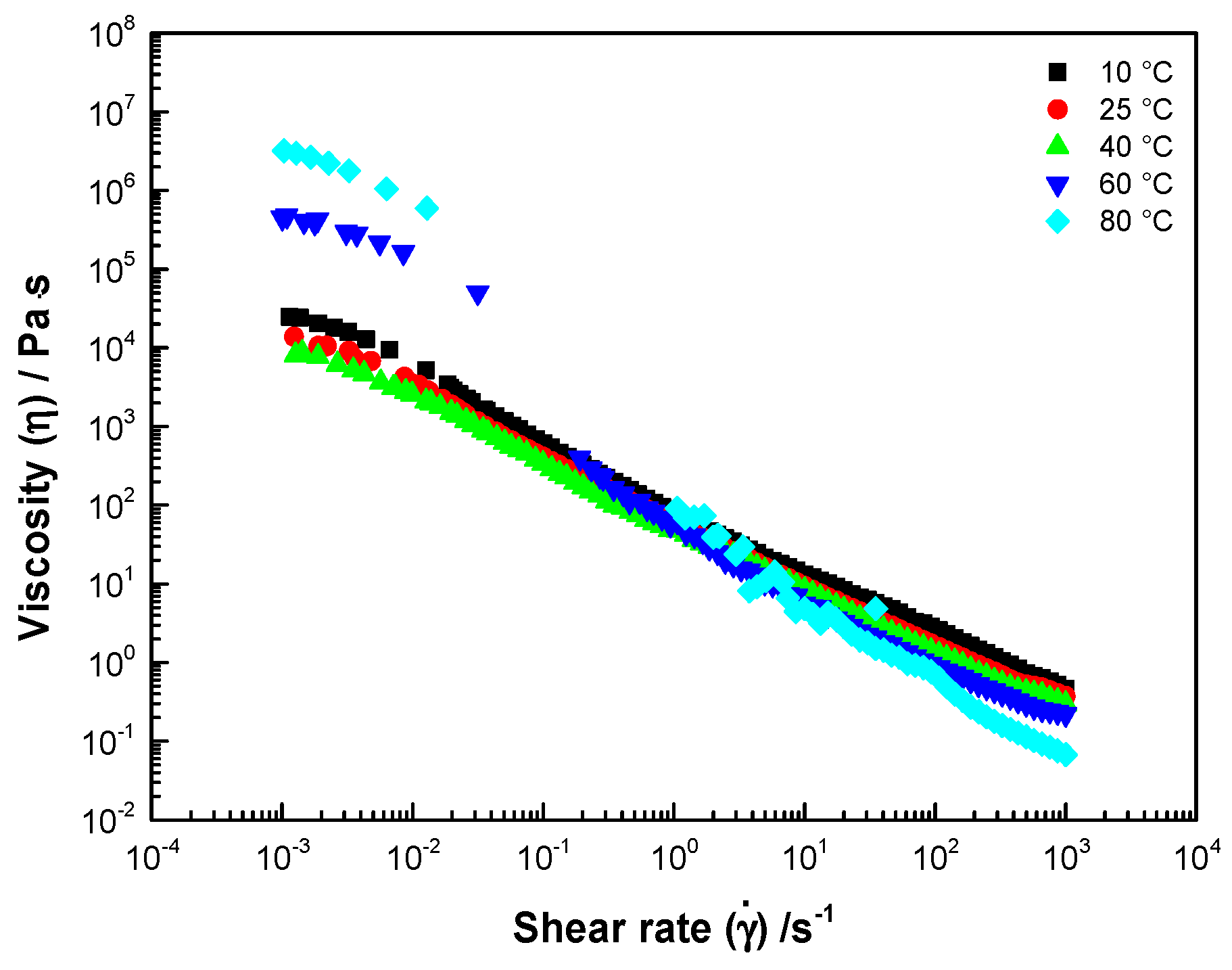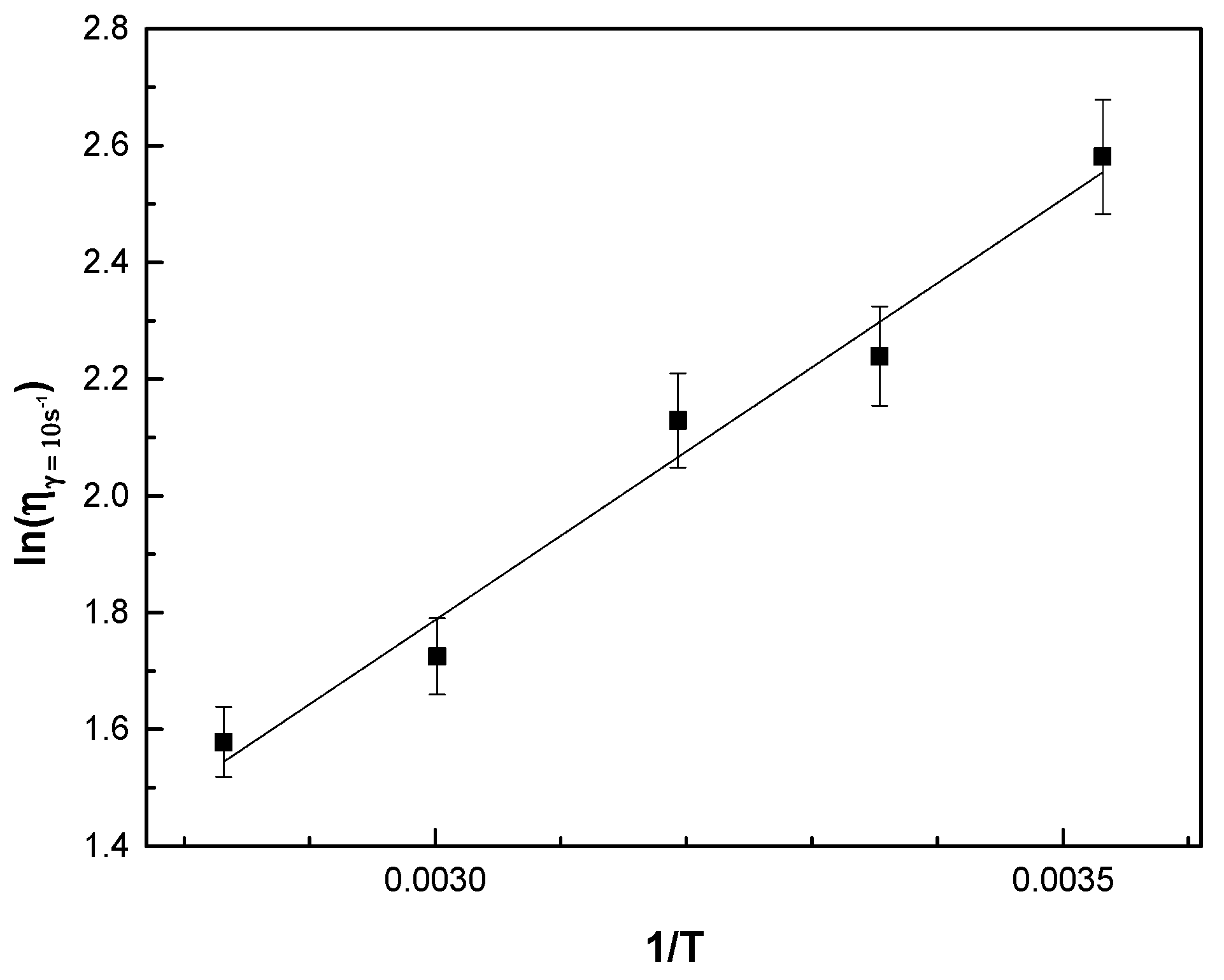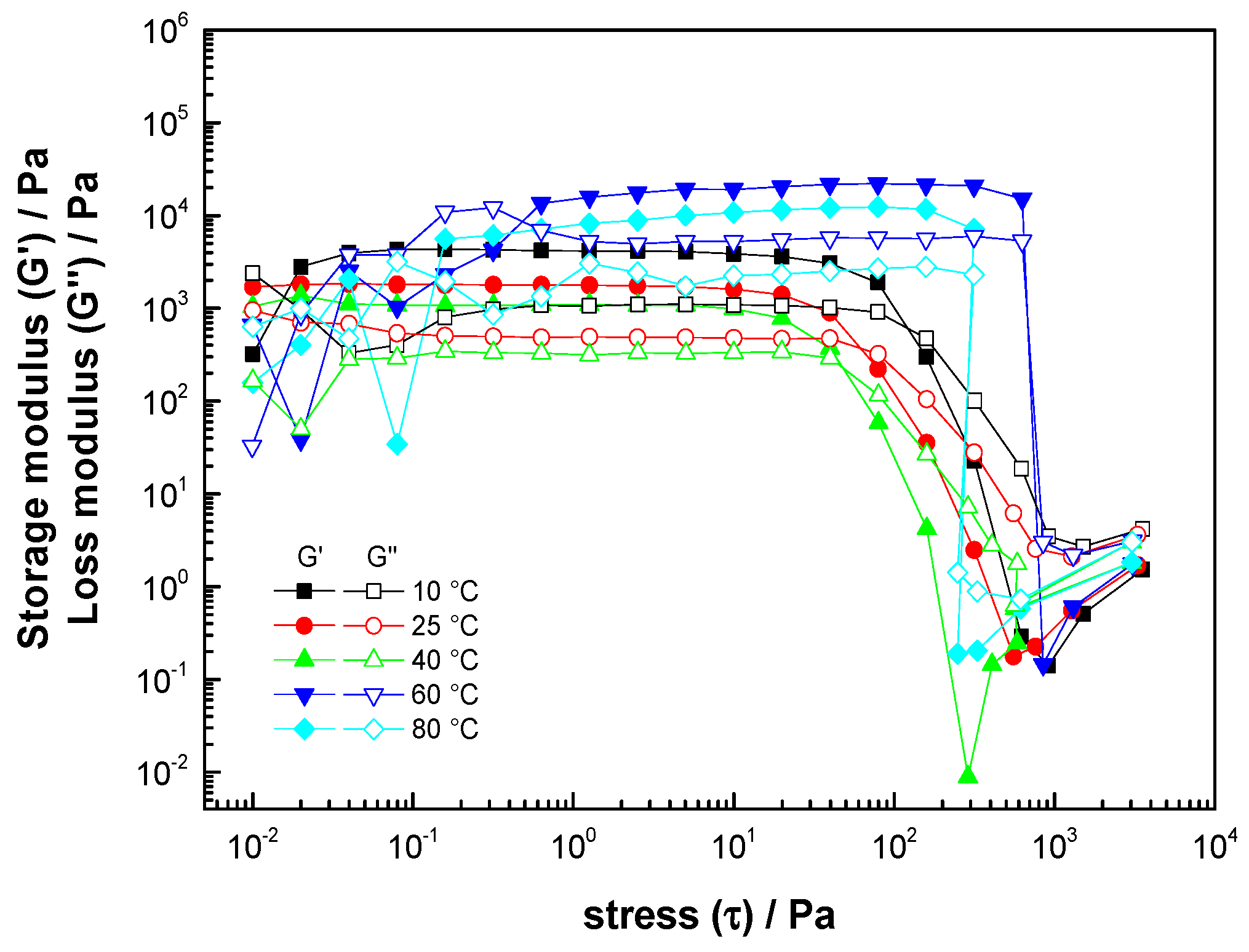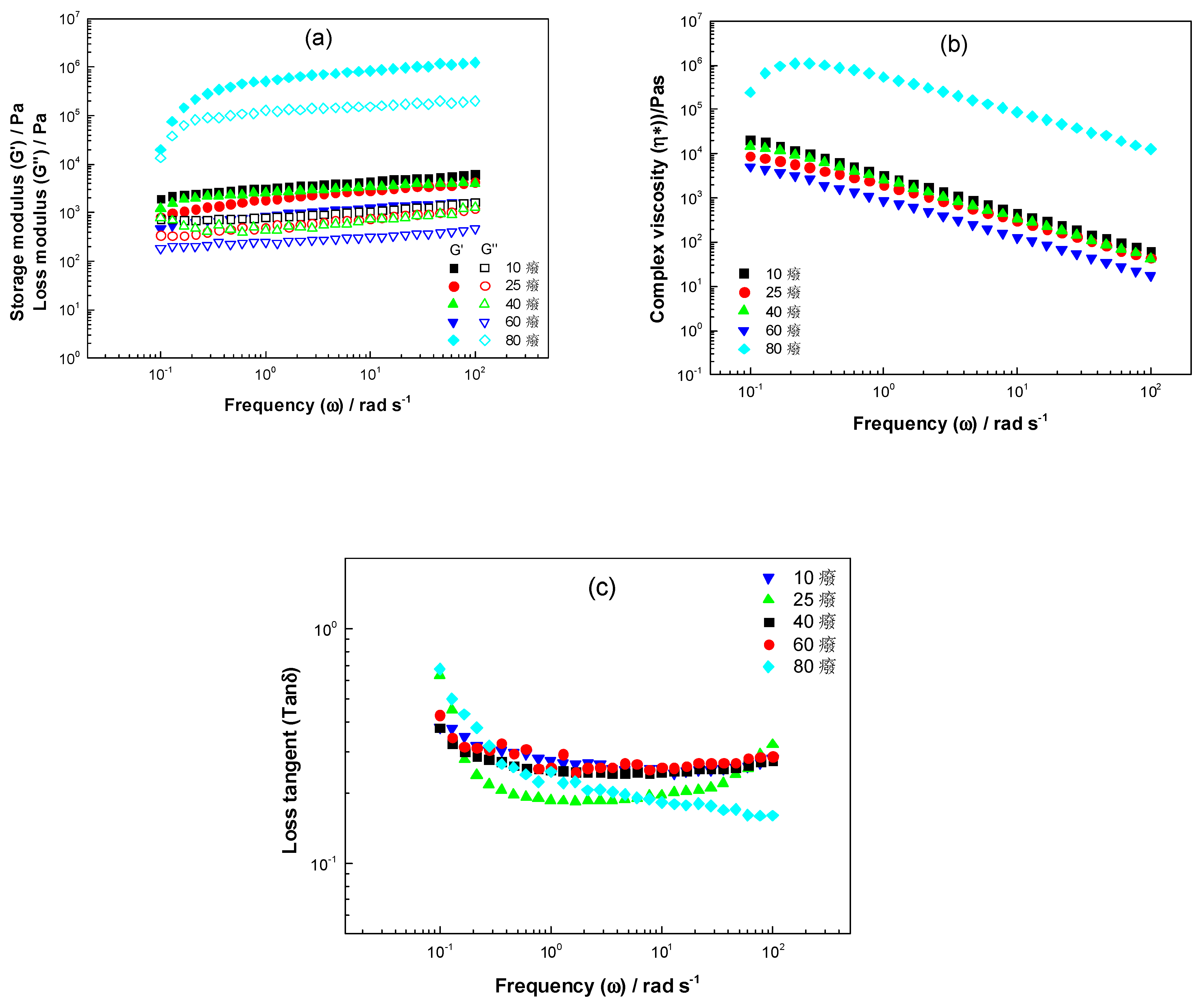Rheological and Functional Properties of Hydrocolloids from Pereskia bleo Leaves
Abstract
:1. Introduction
2. Materials and Methods
2.1. Chemicals
2.2. Hydrocolloid Extraction
2.3. Physicochemical and Proximal Analysis
2.4. Functional Properties
2.4.1. Water Holding Capacity (WHC)
2.4.2. Foaming Capacity (FE) and Foam Stability (FS)
2.4.3. Emulsifying Ability (EA)
2.4.4. Emulsifying Stability (ES)
2.5. Rheological Analysis
2.6. Statistical Analysis
3. Results and Discussion
3.1. Hydrocolloids of Pereskia bleo Leaves
3.2. Rheological Properties
3.2.1. Steady-State Shear Rate
3.2.2. Dynamic Rheological Properties
4. Conclusions
Author Contributions
Funding
Institutional Review Board Statement
Informed Consent Statement
Data Availability Statement
Conflicts of Interest
References
- Zareisedehizadeh, S.; Tan, C.H.; Koh, H.L. A Review of Botanical Characteristics, Traditional Usage, Chemical Components, Pharmacological Activities, and Safety of Pereskia bleo (Kunth) DC. Evid. Based Complement. Altern. Med. 2014, 2014, 326107. [Google Scholar] [CrossRef] [Green Version]
- Er, H.M.; Cheng, E.H.; Radhakrishnan, A.K. Anti-Proliferative and Mutagenic Activities of Aqueous and Methanol Extracts of Leaves from Pereskia bleo (Kunth) DC (Cactaceae). J. Ethnopharmacol. 2007, 113, 448–456. [Google Scholar] [CrossRef]
- Malek, S.N.A.; Shin, S.K.; Wahab, N.A.; Yaacob, H. Cytotoxic Components of Pereskia bleo (Kunth) DC. (Cactaceae) Leaves. Molecules 2009, 14, 1713–1724. [Google Scholar] [CrossRef]
- Sim, K.S.; Sri Nurestri, A.M.; Sinniah, S.K.; Kim, K.H.; Norhanom, A.W. Acute Oral Toxicity of Pereskia bleo and Pereskia grandifolia in Mice. Pharmacogn. Mag. 2010, 6, 67–70. [Google Scholar] [CrossRef]
- Sharif, K.M.; Rahman, M.M.; Azmir, J.; Shamsudin, S.H.; Uddin, M.S.; Fahim, T.K.; Zaidul, I.S.M. Ethanol Modified Supercritical Carbon Dioxide Extraction of Antioxidant Rich Extract from Pereskia bleo. J. Ind. Eng. Chem. 2015, 21, 1314–1322. [Google Scholar] [CrossRef]
- Johari, M.A.; Khong, H.Y. Total Phenolic Content and Antioxidant and Antibacterial Activities of Pereskia bleo. Adv. Pharmacol. Sci. 2019, 2019, 7428593. [Google Scholar] [CrossRef] [PubMed] [Green Version]
- Rani, A.A.; Mahmud, R.; Amran, N.; Asmawi, M.; Mohamed, N.; Perumal, S. In Vivo Hypoglycemic Investigation, Antihyperglycemic and Antihyperlipidemic Potentials of Pereskia bleo Kunth. in Normal and Streptozotocin-Induced Diabetic Rats. Asian Pac. J. Trop. Biomed. 2019, 9, 73. [Google Scholar] [CrossRef]
- Fattepur, S.; Malik, M.Z.B.A.; Nilual, K.; Abdullah, I.; Yusuf, E.; Asmani, M.F.; Fatima, M.A.; Kaleemullah, M. Acute Toxicity and Antifungal Activity of Pereskia bleo Leaves Extracts against Aspergillu. niger and Candida albicans. Int. J. Med. Toxicol. Leg. Med. 2020, 23, 133–137. [Google Scholar] [CrossRef]
- García-Cruz, E.E.; Rodríguez-Ramírez, J.; Méndez Lagunas, L.L.; Medina-Torres, L. Rheological and Physical Properties of Spray-Dried Mucilage Obtained from Hylocereus Undatus Cladodes. Carbohydr. Polym. 2013, 91, 394–402. [Google Scholar] [CrossRef] [PubMed]
- Farhanah, N.; Aluwi, M.; Hamzah, Y.; Zul, M.; Rozaini, H. Chemical and Functional Properties of Rose Cactus (Pereskia bleo) Mucilage as Affected by Different Purification Mediums. Asian J. Agric. Biol. 2019, 7, 10–18. [Google Scholar]
- Tze Hong, N.; Hayati Ibrahim, N. Extraction and characterization of mucilage from leaves of Pereskia bleo (Rose cactus). J. Teknol. Ind. Pangan 2012, 23, 210–216. [Google Scholar] [CrossRef] [Green Version]
- Rajendra Bhosale, R.; Ali Osmani, R.M.; Moin, A. Natural Gums and Mucilages: A Review on Multifaceted Excipients in Pharmaceutical Science and Research. Int. J. Pharmacogn. Phytochem. Res. 2014, 6, 901–912. [Google Scholar]
- Kaewmanee, T.; Bagnasco, L.; Benjakul, S.; Lanteri, S.; Morelli, C.F.; Speranza, G.; Cosulich, M.E. Characterisation of Mucilages Extracted from Seven Italian Cultivars of Flax. Food Chem. 2014, 148, 60–69. [Google Scholar] [CrossRef]
- Archana, G.; Sabina, K.; Babuskin, S.; Radhakrishnan, K.; Fayidh, M.A.; Azhagu Saravana Babu, P.; Sivarajan, M.; Sukumar, M. Preparation and Characterization of Mucilage Polysaccharide for Biomedical Applications. Carbohydr. Polym. 2013, 98, 89–94. [Google Scholar] [CrossRef]
- Prajapati, V.D.; Jani, G.K.; Moradiya, N.G.; Randeria, N.P. Pharmaceutical Applications of Various Natural Gums, Mucilages and Their Modified Forms. Carbohydr. Polym. 2013, 92, 1685–1699. [Google Scholar] [CrossRef]
- Quintana Martínez, S.E.; Torregroza Fuentes, E.E.; García Zapateiro, L.A. Food Hydrocolloids from Butternut Squash (Cucurbita moschata) Peel: Rheological Properties and Their Use in Carica papaya Jam. ACS Omega 2021, 6, 12114–12123. [Google Scholar] [CrossRef]
- Rojas-Torres, S.A.; Quintana, S.E.; García-Zapateiro, L.A. Natural Yogurt Stabilized with Hydrocolloids from Butternut Squash (Cucurbita moschata) Seeds: Effect on Physicochemical, Rheological Properties and Sensory Perception. Fluids 2021, 6, 251. [Google Scholar] [CrossRef]
- Orgulloso-Bautista, S.; Ortega-Toro, R.; Alberto, L.; Zapateiro, G. Design and Application of Hydrocolloids from Butternut Squash (Cucurbita moschata) Epidermis as a Food Additive in Mayonnaise-Type Sauces. ACS Omega 2021, 6, 5499–5508. [Google Scholar] [CrossRef] [PubMed]
- Capitani, M.I.; Corzo-Rios, L.J.; Chel-Guerrero, L.A.; Betancur-Ancona, D.A.; Nolasco, S.M.; Tomás, M.C. Rheological Properties of Aqueous Dispersions of Chia (Salvia hispanica L.) mucilage. J. Food Eng. 2015, 149, 70–77. [Google Scholar] [CrossRef]
- Cervantes-Martínez, C.V.; Medina-Torres, L.; González-Laredo, R.F.; Calderas, F.; Sánchez-Olivares, G.; Herrera-Valencia, E.E.; Gallegos Infante, J.A.; Rocha-Guzman, N.E.; Rodríguez-Ramírez, J. Study of Spray Drying of the Aloe vera Mucilage (Aloe vera barbadensis Miller) as a Function of Its Rheological Properties. LWT Food Sci. Technol. 2014, 55, 426–435. [Google Scholar] [CrossRef]
- Modercay, L.; Bermudez, A.S. Preparación y Determinación de Propiedades Funcionales de Concentrados Proteicos de Haba (Vicia faba). Rev. Colomb. Quím. 2010, 23, 73–86. [Google Scholar]
- Jahanbin, K.; Moini, S.; Gohari, A.R.; Emam-Djomeh, Z.; Masi, P. Isolation, Purification and Characterization of a New Gum from Acanthophyllum bracteatum Roots. Food Hydrocoll. 2012, 27, 14–21. [Google Scholar] [CrossRef]
- Sciarini, L.S.; Maldonado, F.; Ribotta, P.D.; Pérez, G.T.; León, A.E. Chemical Composition and Functional Properties of Gleditsia triacanthos Gum. Food Hydrocoll. 2009, 23, 306–313. [Google Scholar] [CrossRef]
- Quintana-Martinez, S.; Morales-Cano, A.; García-Zapateiro, L. Rheological Behaviour in the Interaction of Lecithin and Guar Gum for Oil-in-Water Emulsions. Czech J. Food Sci. 2018, 36, 73–80. [Google Scholar] [CrossRef] [Green Version]
- Gannasin, S.P.; Adzahan, N.M.; Mustafa, S.; Muhammad, K. Techno-Functional Properties and in vitro Bile Acid-Binding Capacities of Tamarillo (Solanum betaceum Cav.) Hydrocolloids. Food Chem. 2016, 196, 903–909. [Google Scholar] [CrossRef]
- Amid, B.T.; Mirhosseini, H. Optimisation of Aqueous Extraction of Gum from Durian (Durio zibethinus) Seed: A Potential, Low Cost Source of Hydrocolloid. Food Chem. 2012, 132, 1258–1268. [Google Scholar] [CrossRef] [PubMed]
- Alfredo, V.O.; Gabriel, R.R.; Luis, C.G.; David, B.A. Physicochemical Properties of a Fibrous Fraction from Chia (Salvia hispanica L.). LWT Food Sci. Technol. 2009, 42, 168–173. [Google Scholar] [CrossRef]
- Dickinson, E. Hydrocolloids Acting as Emulsifying Agents—How Do They Do It? Food Hydrocoll. 2018, 78, 2–14. [Google Scholar] [CrossRef]
- Liang, R.; Wang, L.; Chen, J.; Liu, W.; Liu, C.M. Alkylated Pectin: Synthesis, Characterization, Viscosity and Emulsifying Properties. Food Hydrocoll. 2015, 50, 65–73. [Google Scholar] [CrossRef]
- Damodaran, S. Protein Stabilization of Emulsions and Foams. J. Food Sci. 2006, 70, R54–R66. [Google Scholar] [CrossRef]
- Gharbi, N.; Labbafi, M. Influence of Treatment-Induced Modification of Egg White Proteins on Foaming Properties. Food Hydrocoll. 2019, 90, 72–81. [Google Scholar] [CrossRef]
- Dickinson, E. Food Emulsions and Foams: Stabilization by Particles. Curr. Opin. Colloid Interface Sci. 2010, 15, 40–49. [Google Scholar] [CrossRef]
- Deng, Y.; Huang, L.; Zhang, C.; Xie, P.; Cheng, J.; Wang, X. Physicochemical and Functional Properties of Water Soluble Gum from Wrinkle Floweringquince (Chaenomeles speciosa) Seeds. J. Bioresour. Bioprod. 2019, 4, 222–230. [Google Scholar] [CrossRef]
- Farahmandfar, R.; Asnaashari, M.; Salahi, M.R.; Khosravi Rad, T. Effects of Basil Seed Gum, Cress Seed Gum and Quince Seed Gum on the Physical, Textural and Rheological Properties of Whipped Cream. Int. J. Biol. Macromol. 2017, 98, 820–828. [Google Scholar] [CrossRef]
- Koocheki, A.; Taherian, A.R.; Bostan, A. Studies on the Steady Shear Flow Behavior and Functional Properties of Lepidium perfoliatum Seed Gum. Food Res. Int. 2013, 50, 446–456. [Google Scholar] [CrossRef]
- SPEERS, R.A.; TUNG, M.A. Concentration and Temperature Dependence of Flow Behavior of Xanthan Gum Dispersions. J. Food Sci. 1986, 51, 96–98. [Google Scholar] [CrossRef]
- Kutlu, G.; Bozkurt, F.; Tornuk, F. Extraction of a Novel Water-Soluble Gum from Nettle (Urtica dioica) Seeds: Optimization and Characterization. Int. J. Biol. Macromol. 2020, 162, 480–489. [Google Scholar] [CrossRef]
- Karazhiyan, H.; Razavi, S.M.A.; Phillips, G.O.; Fang, Y.; Al-Assaf, S.; Nishinari, K.; Farhoosh, R. Rheological Properties of Lepidium sativum Seed Extract as a Function of Concentration, Temperature and Time. Food Hydrocoll. 2009, 23, 2062–2068. [Google Scholar] [CrossRef]
- Xu, L.; Xu, G.; Liu, T.; Chen, Y.; Gong, H. The Comparison of Rheological Properties of Aqueous Welan Gum and Xanthan Gum Solutions. Carbohydr. Polym. 2013, 92, 516–522. [Google Scholar] [CrossRef] [PubMed]
- Campo-Deaño, L.; Tovar, C.A.; Borderías, J. Effect of Several Cryoprotectants on the Physicochemical and Rheological Properties of Suwari Gels from Frozen Squid Surimi Made by Two Methods. J. Food Eng. 2010, 97, 457–464. [Google Scholar] [CrossRef]
- Razavi, S.M.A.; Alghooneh, A.; Behrouzian, F. Influence of Temperature on Sage Seed Gum (Salvia macrosiphon) Rheology in Dilute and Concentrated Regimes. J. Dispers. Sci. Technol. 2018, 39, 982–995. [Google Scholar] [CrossRef]
- Mezger, T.G. The Rheology Handbook: For Users of Rotational and Oscillatory Rheometers. Available online: https://books.google.com.co/books/about/The_Rheology_Handbook.html?id=N9Fdn0MEIDIC&redir_esc=y (accessed on 15 March 2021).
- Chuang, G.C.C.; Yeh, A.I. Rheological Characteristics and Texture Attributes of Glutinous Rice Cakes (Mochi). J. Food Eng. 2006, 74, 314–323. [Google Scholar] [CrossRef]
- Alghooneh, A.; Razavi, S.M.A.; Behrouzian, F. Rheological Characterization of Hydrocolloids Interaction: A Case Study on Sage Seed Gum-Xanthan Blends. Food Hydrocoll. 2017, 66, 206–215. [Google Scholar] [CrossRef]
- Perduca, M.J.; Spotti, M.J.; Santiago, L.G.; Judis, M.A.; Rubiolo, A.C.; Carrara, C.R. Rheological Characterization of the Hydrocolloid from Gleditsia amorphoides Seeds. LWT Food Sci. Technol. 2013, 51, 143–147. [Google Scholar] [CrossRef]
- Dávila, J.L.; d’Ávila, M.A. Laponite as a Rheology Modifier of Alginate Solutions: Physical Gelation and Aging Evolution. Carbohydr. Polym. 2017, 157, 1–8. [Google Scholar] [CrossRef] [PubMed]
- Taki, A.; John, B.; Arakawa, S.; Okamoto, M. Structure and Rheology of Nanocomposite Hydrogels Composed of DNA and Clay. Eur. Polym. J. 2013, 49, 923–931. [Google Scholar] [CrossRef]
- Robinson, G.; Manning, C.E.; Morris, E.R. Conformation and Physical Properties of the Bacterial Polysaccharides Gellan, Welan, and Rhamsan. In Food Polymers, Gels and Colloids; Elsevier Royal Society of Chemistry: Cambridge, UK, 1991; pp. 22–33. [Google Scholar]




| Parameter | Hydrocolloids |
|---|---|
| Moisture (%) | 13.68 ± 0.38 |
| Protein (%) | 3.3 ± 0.27 |
| Fat (%) | 0.636 ± 0.03 |
| Ash (%) | 1.48 ± 0.05 |
| Carbohydrate (%) | 80.91 ± 0.54 |
| mL/g WHC | 3.62 ± 0.04 |
| %ES 0.1 | 60.4 ± 0.13 |
| %ES 0.25 | 68.6 ± 0.04 |
| %ES 0.5 | 73.9 ± 0.07 |
| %FE | 5.47 ± 0.07 |
| %FS | 1% |
| Temperature °C | Pa·s | Pa·s | C s | m | R2 |
|---|---|---|---|---|---|
| 10 | 40,376.08 c | 0.518 c | 858.45 d | 0.81 a | 0.95 |
| 25 | 20,471.30 b | 0.475 c | 302.97 c | 1.02 a | 0.94 |
| 40 | 14,141.91 a | 0.247 b | 321.46 c | 0.95 a | 0.93 |
| 60 | 578,300.86 d | 0.216 b | 258.39 b | 1.42 b | 0.98 |
| 80 | 874,423.83 e | 0.007 a | 118.54 a | 1.50 b | 0.96 |
| Temperature °C | Pa | Pa | Pa | Pa |
|---|---|---|---|---|
| 10 | 4096.13 c | 1120.57 c | 21.62 a | 1671 e |
| 25 | 1694.32 b | 448.22 b | 23.14 a | 425.4 d |
| 40 | 1089.70 a | 317.00 a | 21.89 a | 265.4 b |
| 60 | 19,909.45 d | 5989.25 e | 79.31 b | 399.4 c |
| 80 | 11,644.49 e | 2316.74 d | 194.4 c | 185.2 a |
| Temperature °C | Pa | Pa | Pa·s | |
|---|---|---|---|---|
| 10 | 4052 c | 989.8 d | 695.8 d | 0.24 b |
| 25 | 2663 b | 705.8 c | 459.5 b | 0.26 b |
| 40 | 3193 c | 593.7 b | 541.8 c | 0.24 b |
| 60 | 1169 a | 300.5 a | 201.3 a | 0.25 b |
| 80 | 778,200 d | 147,700 e | 132,100 e | 0.19 a |
Publisher’s Note: MDPI stays neutral with regard to jurisdictional claims in published maps and institutional affiliations. |
© 2021 by the authors. Licensee MDPI, Basel, Switzerland. This article is an open access article distributed under the terms and conditions of the Creative Commons Attribution (CC BY) license (https://creativecommons.org/licenses/by/4.0/).
Share and Cite
López-Barraza, D.; Ortega-Ramos, A.; Torregroza-Fuentes, E.; Quintana, S.E.; García-Zapateiro, L.A. Rheological and Functional Properties of Hydrocolloids from Pereskia bleo Leaves. Fluids 2021, 6, 349. https://doi.org/10.3390/fluids6100349
López-Barraza D, Ortega-Ramos A, Torregroza-Fuentes E, Quintana SE, García-Zapateiro LA. Rheological and Functional Properties of Hydrocolloids from Pereskia bleo Leaves. Fluids. 2021; 6(10):349. https://doi.org/10.3390/fluids6100349
Chicago/Turabian StyleLópez-Barraza, Diana, Andres Ortega-Ramos, Edilbert Torregroza-Fuentes, Somaris E. Quintana, and Luis A. García-Zapateiro. 2021. "Rheological and Functional Properties of Hydrocolloids from Pereskia bleo Leaves" Fluids 6, no. 10: 349. https://doi.org/10.3390/fluids6100349
APA StyleLópez-Barraza, D., Ortega-Ramos, A., Torregroza-Fuentes, E., Quintana, S. E., & García-Zapateiro, L. A. (2021). Rheological and Functional Properties of Hydrocolloids from Pereskia bleo Leaves. Fluids, 6(10), 349. https://doi.org/10.3390/fluids6100349








